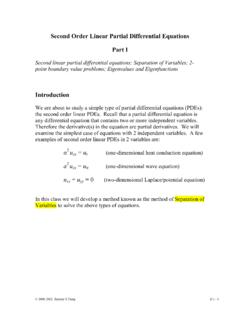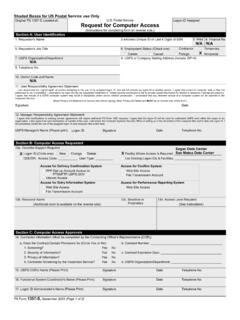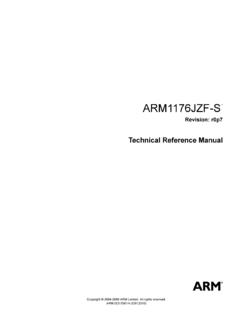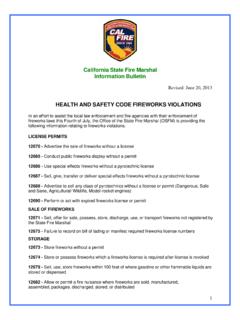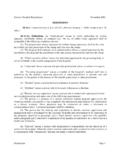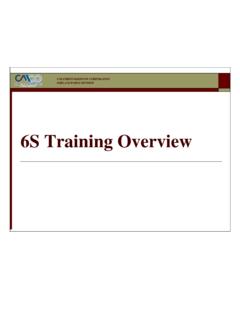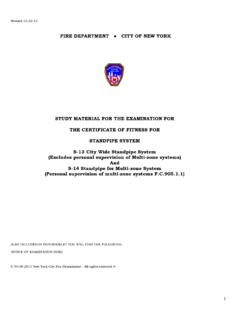Transcription of Partial Fraction Decomposition for Inverse Laplace …
1 Partial Fraction Decomposition for Inverse Laplace Trans-formUsually Partial fractions method starts withpolynomial long divisionin order torepresent a Fraction as a sum of a polynomial and an another Fraction , where thedegree of the polynomial in the numerator of the new fractionis less than the degreeof the polynomial in its denominator:s3+ 1s2+ 1=s+ s+ 1s2+ , however,neverhave to do this polynomial long division, when Partial FractionDecomposition is applied to problems from Chapter important fact in Chapter 6 is that we use only the followingthreetypesof a(s a)2+b2, (s a)2+b2, (s a)n,because we know the corresponding Inverse Laplace 1 s a(s a)2+b2 =eatcos(bt), 1 b(s a)2+b2 =eatsin(bt),(1) 1 1s a =eat,L 1 1(s a)2 =teat,L 1 1(s a)3 =t22eat,(2)L 1 1(s a)4 =t36eat,L 1 1(s a)5 =t424eat.
2 L 1 1(s a)n+1 =tnn!eatWe will call fractions 1,2,3 asstandard fractions . The Partial Fraction Decompositionfor Inverse Laplace Transform is as 1 Suitable Decomposition . The objective of this step is to give the correctformat of the Partial Fraction Decomposition for a given of suitable Decomposition :1. Numerator does not Number of standard fractions equals the degree of the Number of undetermined constants equals the degree of All standard fractions involved should be Scenario. When you solve a homogeneous equationay +by +cy= 0youalwayshave to solveY=??as2+bs+c,where I put ?? in the numerator (because by Rule 1 the numerator does not matter inStep 1), and in the denominator you will have the characteristic polynomial.
3 Since thecharacteristic polynomial is quadratic you will need two different standard fractions (Rule 2 and 4) and two undetermined constants (Rule 3).There are three cases )as2+bs+c= 0 has two distinct real roots. Example??s2 3s 4=A1s 4+B1s+ 3s 4 = (s 4)(s+ 1). As in the example above, here the rule is that thetwo (different) standard fractions should be1s S1,1s S2,whereS1andS2are the roots ofas2+bs+c= examples??s2+s=A1s+B1s+ 1,??s2 1=A1s+ 1+B1s )as2+bs+c= 0 has two repeated real roots. Example??s2 2s+ 1=A1s 1+B1(s 1) 2s+ 1 = (s 1)2. As in the example above, here the rule is that the two(different) standard fractions should be1s S,1(s S)2,whereSis the repeated root ofas2+bs+c= examples??s2=A1s+B1s2,??s2+ 6s+ 9=A1s+ 3+B1(s+ 3) that for the cases a) and b) you will need to use the first formula in (2) for theInverse Laplace )as2+bs+c= 0 has two complex roots.
4 Example??s2 2s+ 5=As 1(s 1)2+ 4+B2(s 1)2+ 2s+ 5 = (s 1)2+ 4. As in the example above, here the rule is that thetwo (different) standard fractions should bes k(s k)2+m2,b(s k)2+m2,where the denominator (s k)2+m2is obtained my completing the squares:as2+bs+c=a (s k)2+m2 .Further examples??4s2+ 4s+ 5=As+ 1/2(s+ 1/2)2+ 1+B1(s+ 1/2)2+ 1,??s2+ 5=Ass2+ 5+B 5s2+ Complicated Scenario. When you solve a nonhomogeneous equationay +by +cy=g(t) you will have to deal with a Fraction , which denominator is of degree3 or higher. The same four rules of suitable Decomposition still apply here:1. Numerator does not Number of standard fractions equals the degree of the Number of undetermined constants equals the degree of All standard fractions involved should be first preliminary step we have to take here is to decomposethe denominatorinto a product standard polynomials.
5 These standard polynomial are exactly of twotypesa) (s a)nb) and (s k)2+m2 .Examples(s 1)(s2+ 4s+ 3) = (s 1)(s+ 1)(s+ 3),(s 1)(s2+ 4s+ 5) = (s 1)((s+ 2)2+ 1),(s 1)(s2+ 4s 5) = (s 1)(s 1)(s+ 5) = (s 1)2(s+ 5).Note that in the last example above wehave tocombine two terms (s 1) into one(s 1)2, so that all the involved standard polynomials havedistinct standard fractions that arise in this more complicated scenario are identicalto the ones that we discussed in the simplest case with one exception. We may nowneed to use1(s S)3,1(s S)4,1(s S)5, ..For example??(s 3)4=A1s 3+B1(s 3)2+C1(s 3)3+D1(s 3) everything else we just use the rule that we need to get theappropriate numberof fractions for each standard polynomial in our denominator and just add them uptogether.
6 For example, suppose you need to find a suitable form of a Partial fractionsdecomposition for??s4((s+ 1)2+ 1)(s2+ 1)(s 1)2(s2 1)You first observe that there is one further decomposable Fraction :s2 1 = (s 1)(s+1).Therefore??s4((s+ 1)2+ 1)(s2+ 1)(s 1)2(s2 1)=??s4((s+ 1)2+ 1)(s2+ 1)(s 1)3(s+ 1),and the denominator is the product of five standard fractions :s4, (s+ 1)2+ 1,s2+ 1,(s 1)3,s+ 1. For each one of them individually we know what we should do:??s4=A1s+B1s2+C1s3+D1s4,??(s+ 1)2+ 1=As+ 1(s+ 1)2+ 1+B1(s+ 1)2+ 1,??s2+ 1=Ass2+ 1+B1s2+ 1,??(s 1)3=A1s 1+B1(s 1)2+C1(s 1)3,??s+ 1=A1s+ , for the products4((s+ 1)2+ 1)(s2+ 1)(s 1)3(s+ 1), we should just add theindividual suitable Partial decompositions??s4((s+ 1)2+ 1)(s2+ 1)(s 1)3(s+ 1)=A1s+B1s2+C1s3+D1s4+Es+ 1(s+ 1)2+ 1+F1(s+ 1)2+ 1+Gss2+ 1+H1s2+ 1+I1s 1+J1(s 1)2+K1(s 1)3+L1s+ 2 Evaluation of the undetermined matters.
7 A first preliminary step here is to reduce the problemto an equality of polynomials. The bullet-proof way to do it is to multiply by thedenominator of your given Fraction in its standard + 2s+ 3(s+ 1)(s2+ 2s+ 2)=A1s+ 1+Bs+ 1(s+ 1)+1+C1(s+ 1)+1,where (s+ 1)(s2+ 2s+ 2) = (s+ 1)((s+ 1)2+ 1).((s+ 1)((s+ 1)2+ 1)) (s2+ 2s+ 3)(s+ 1)(s2+ 2s+ 2)=A(s+ 1)((s+ 1)2+ 1)s+ 1+B(s+ 1)(s+ 1)((s+ 1)2+ 1)(s+ 1)+1+C(s+ 1)((s+ 1)2+ 1)(s+ 1)+1, (s+ 1)((s+ 1)2+ 1) (s2+ 2s+ 3) =A((s+ 1)2+ 1) +B(s+ 1)(s+ 1) +C(s+ 1).Then you need to find the undetermined constants. You do that by finding linearequations for these constants. The number of equations should be equal to the numberof unknowns. Apart from small tricks, there are two major methods: evaluationof your expression for some values of s, and comparison of coefficients for of )Evaluation at some pointsThis method is very effective when the denominator hasonlydistinct + 1s(s+ 1)(s 1)=A1s+B1s+ 1+C1s 1,s2+ 1 =A(s+ 1)(s 1) +Bs(s 1) +Cs(s+ 1),s= 0,1 = A;s= 1,2 = 2C;s= 1,2 = 1, B= 1, C= + 1s(s+ 1)(s 1)=1s+1s+ 1 1s )Comparison of coefficientsThis method is bullet-proof, but it is quite + 1s(s+ 1)(s 1)=A1s+B1s+ 1+C1s 1,s2+ 1 =A(s+ 1)(s 1) +Bs(s 1) +Cs(s+ 1),s2+ 1 =As2 A+Bs2 Bs+Cs2+Cs= (A+B+C)s2+ (C B)s A,On the right-hand side the coefficients in front ofs2,s, and 1 are 1, 0, and 1, respec-tively.
8 On the left-hand side the coefficients in front ofs2,s, and 1 areA+B+C,C B, and A, respectively. Therefore 1 =A+B+C,0 =C B,1 = A,Solving the above system we obtainA= 1, B= 1, C= + 1s(s+ 1)(s 1)=1s+1s+ 1+1s you see, in the above example the evaluation method is somewhat better thanthe comparison method. Try to do the evaluation method for the next problem andcompare with the following (s2+ 1)(s2+ 4)=Ass2+ 1+B1s2+ 1+Css2+ 4+D2s2+ (s2+ 4) +B(s2+ 4) +Cs(s2+ 1) +D(s2+ 1)= (A+C)s3+ (B+D)s2+ (4A+C)s+ (4B+D). 1 =A+C,0 =B+D,0 = 4A+C,0 = 4B+D,From the second and the fourth equation above we obtainB=D= 0. The first andthe third equations giveA= 1/3,C= 4 (s2+ 1)(s2+ 4)= 13ss2+ 1+43ss2+ 4.







